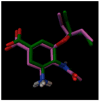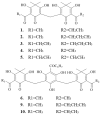Anti-Influenza Virus (H5N1) Activity Screening on the Phloroglucinols from Rhizomes of Dryopteris crassirhizoma
- PMID: 28282885
- PMCID: PMC6155227
- DOI: 10.3390/molecules22030431
Anti-Influenza Virus (H5N1) Activity Screening on the Phloroglucinols from Rhizomes of Dryopteris crassirhizoma
Abstract
For screening the active phloroglucinols on influenza virus (H5N1) from Dryopteris crassirhizoma NaKai, a database was established including twenty-three phloroglucinols that had been isolated from Dryopteris crassirhizoma. Their inhibitory effect on the neuraminidase (NA) of influenza virus H5N1 was screened by molecular docking. As a result, three candidates were selected. The rhizomes of D. crassirhizoma were subjected to isolation and purification processes to obtain the inhibitor candidates. Thirteen phloroglucinols were obtained, including three selected candidates and two new phloroglucinols. The five phloroglucinols were investigated for their inhibitory activity on NA in vitro. The results showed that dryocrassin ABBA and filixic acid ABA exhibited inhibitory effects on NA with IC50 as 18.59 ± 4.53 and 29.57 ± 2.48 μM, respectively, and the other three phloroglucinols showed moderate inhibitory activity. Moreover, the anti-influenza virus (H5N1) activity and cytotoxicity of dryocrassin ABBA and filixic acid ABA were tested on Madin-Darby canine kidney (MDCK) cells with the cell counting kit-8 (CCK8) method. The results confirmed that dryocrassin ABBA exhibited an inhibitory activity with low cytotoxicity (TC50 > 400 μM) against influenza virus (H5N1) which will have to be investigated in further detail. In conclusion, phloroglucinols from D. crassirhizoma were shown to have anti-influenza virus activity, and especially dryocrassin ABBA, one of the phloroglucinols, may have the potential to control influenza virus (H5N1) infection.
Keywords: Dryopteris crassirhizoma; dryocrassin ABBA; influenza virus H5N1; neuraminidase; phloroglucinols.
Conflict of interest statement
The authors declare no conflict of interest.
Figures












Similar articles
-
Anticoronaviral Activity of the Natural Phloroglucinols, Dryocrassin ABBA and Filixic Acid ABA from the Rhizome of Dryopteris crassirhizoma by Targeting the Main Protease of SARS-CoV-2.Pharmaceutics. 2022 Feb 8;14(2):376. doi: 10.3390/pharmaceutics14020376. Pharmaceutics. 2022. PMID: 35214108 Free PMC article.
-
PTP1B inhibition studies of biological active phloroglucinols from the rhizomes of Dryopteris crassirhizoma: Kinetic properties and molecular docking simulation.Int J Biol Macromol. 2021 Oct 1;188:719-728. doi: 10.1016/j.ijbiomac.2021.08.091. Epub 2021 Aug 17. Int J Biol Macromol. 2021. PMID: 34416263
-
Total synthesis of dryocrassin ABBA and its analogues with potential inhibitory activity against drug-resistant neuraminidases.Bioorg Med Chem. 2019 Sep 1;27(17):3846-3852. doi: 10.1016/j.bmc.2019.07.013. Epub 2019 Jul 8. Bioorg Med Chem. 2019. PMID: 31324565
-
Anticoronavirus activity of rhizome of Dryopteris crassirhizoma via multistage targeting of virus entry and viral proteases, Mpro and PLpro.J Ethnopharmacol. 2024 Oct 28;333:118490. doi: 10.1016/j.jep.2024.118490. Epub 2024 Jun 25. J Ethnopharmacol. 2024. PMID: 38925321
-
Recent advances in neuraminidase inhibitor development as anti-influenza drugs.ChemMedChem. 2012 Sep;7(9):1527-36. doi: 10.1002/cmdc.201200155. Epub 2012 Jul 16. ChemMedChem. 2012. PMID: 22807317 Review.
Cited by
-
Inhibitory Activity of Bioactive Phloroglucinols from the Rhizomes of Dryopteris crassirhizoma on Escherichia coli β-Glucuronidase: Kinetic Analysis and Molecular Docking Studies.Metabolites. 2022 Oct 2;12(10):938. doi: 10.3390/metabo12100938. Metabolites. 2022. PMID: 36295840 Free PMC article.
-
Ergosterol Protects Canine MDCK Cells from Gentamicin-Induced Damage by Modulating Autophagy and Apoptosis.Metabolites. 2025 Jun 5;15(6):373. doi: 10.3390/metabo15060373. Metabolites. 2025. PMID: 40559397 Free PMC article.
-
In vivo and in vitro anti‑allergic and anti‑inflammatory effects of Dryopteris crassirhizoma through the modulation of the NF‑ĸB signaling pathway in an ovalbumin‑induced allergic asthma mouse model.Mol Med Rep. 2020 Nov;22(5):3597-3606. doi: 10.3892/mmr.2020.11460. Epub 2020 Aug 25. Mol Med Rep. 2020. PMID: 33000211 Free PMC article.
-
Recent advances of phenotypic screening strategies in the application of anti-influenza virus drug discovery.RSC Med Chem. 2023 Nov 9;15(1):70-80. doi: 10.1039/d3md00513e. eCollection 2024 Jan 25. RSC Med Chem. 2023. PMID: 38283223 Free PMC article. Review.
-
Insights into Chemical Diversity and Potential Health-Promoting Effects of Ferns.Plants (Basel). 2024 Sep 23;13(18):2668. doi: 10.3390/plants13182668. Plants (Basel). 2024. PMID: 39339643 Free PMC article. Review.
References
-
- Kwon H.I., Song M.S., Pascua P.N.Q., Baek Y.H., Lee J.H., Hong S.-P., Rho J.-B., Kim J.-K., Poo H., Kim C.-J., et al. Genetic characterization and pathogenicity assessment of highly pathogenic H5N1 avian influenza viruses isolated from migratory wild birds in 2011, South Korea. Virus Res. 2011;160:305–315. doi: 10.1016/j.virusres.2011.07.003. - DOI - PubMed
MeSH terms
Substances
LinkOut - more resources
Full Text Sources
Other Literature Sources
Medical
Research Materials

